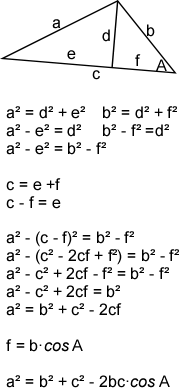- Location
- Tennessee NEC:2017
- Occupation
- Semi-Retired Electrician
This may belong in the "electrical calculation/engineering" forum but it's not quite either.
So here is my question, basic to you maybe, but I missed that day in school!:happyyes:
If you measure/draw a straight line from point "A" to point "B" and get 25'
Then a straight line at a 90° angle to the first line, point "B" to point "C" and get 23'
Now instead of measuring "A" to "B" to "C" using a right angle, how could you determine the distance from "A" to "C" in a straight line without measuring?
So here is my question, basic to you maybe, but I missed that day in school!:happyyes:
If you measure/draw a straight line from point "A" to point "B" and get 25'
Then a straight line at a 90° angle to the first line, point "B" to point "C" and get 23'
Now instead of measuring "A" to "B" to "C" using a right angle, how could you determine the distance from "A" to "C" in a straight line without measuring?


